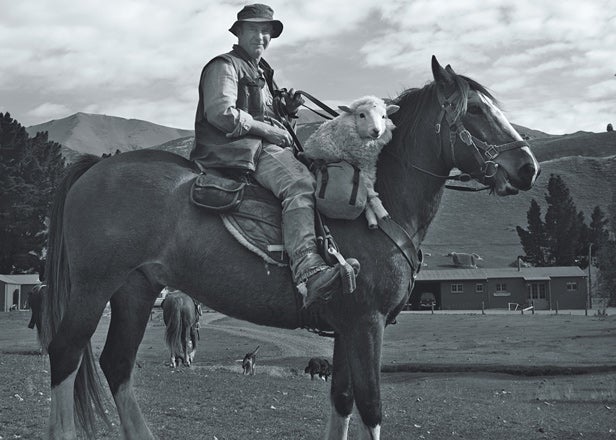This Colorado-size country is home to more than four million people, nearly all of them rabid bikers, climbers, trekkers, paddlers … you get the idea. There are world-class opportunities for virtually every outdoor sport, and the unofficial national motto is “Get amongst it.”
Start by choosing the right island. The North Island has yacht racing, trout fishing, mountain biking, volcanoes, hot springs, crater lakes, and under-the-radar surfing, as well as the citiesÔÇöAuckland (405,000) and Wellington (180,000)ÔÇöand most of the native Maori culture. The sparsely populated South Island has long-distance trekking, mountaineering, backcountry skiing, cycling, mountain biking, whitewater kayaking, and adrenaline pursuits like bungee and BASE jumping. By habit, locals here tend to do many of these in the same day.
Go Mobile
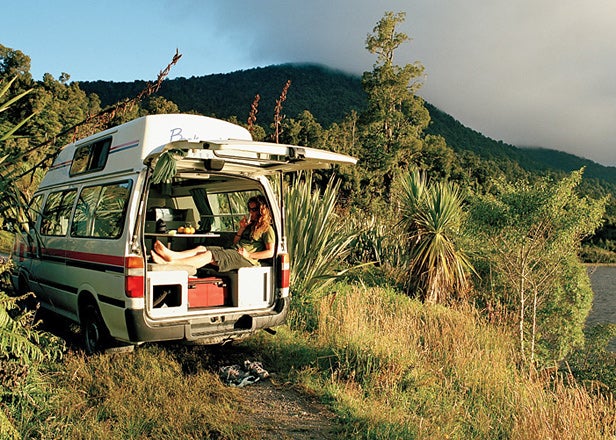
Hands-down the best way to see the country is to rent a sweet RV, especially for longer trips. Unlike in the U.S., where RVs are often corralled into concrete “parks,” New Zealand has a “freedom camping” ethos. That means you can pull off the road almost anywhere, as long as your rig has a toilet on board and you’re not in a city or the restricted zone of a national park. RVs also make great rolling gear garages (kayaks, bikes, packs, raingear …), and having a refrigerator means you can cook green-lipped mussels at sunset. Two planning suggestions: prepare mentally to drive a large vehicle on the left side of the road, and budget for a pit stop or two at one of New Zealand’s legendary lodges.
If you have three or more weeks, it’s worth touring both islands. Most international flights land in Auckland, and if you head (mostly) south from there, it’s roughly 1,200 miles and a half-dozen climatesÔÇöfrom subtropical coast to high-alpine glaciersÔÇöto Fiordland National Park. But a truly epic adventure might have you logging 2,500 miles or more. On the North Island, spend some days on the Pacific Coast Highway, lazing on the beaches of the Coromandel Peninsula or surfing the beach breaks in Tauranga. Turn inland on Highway 33 and hit Rotorua’s famous hot springs and mountain-bike trails. Eventually you’ll want to roll through the Hawke’s Bay wine country to Wellington, the antipodean San Francisco and port for the Interislander Ferry, which crosses Cook Strait in three hours (prices vary by vehicle; ).
The road tripper’s route on the South Island is Highway 6 along the wild west coast and the Tasman Sea. It’s oceanside car camping out there and an easy three days to the Franz Josef and Fox glaciers (guided glacier walks at both spots; and ). Inland over the Haast Pass is the adrenaline-sports capital of Queenstown, the birthplace of commercial bungee jumping and guided canyoneering adventures (see “Get Amped”). You could play here for a week, but it’s worth cruising farther down the island to Fiordland National Park, where the road dead-ends at Milford Sound and sheer rock faces plunge into an inlet full of whales, seals, penguins, and dolphins.
Your RV provider: United Campervan (), which has a wide selection of models (daily prices vary depending on the season and vehicle), or Christchurch-based Natural High, which offers RVs and any combination of kayak, bike, and camping-gear rental ().
Kick Back
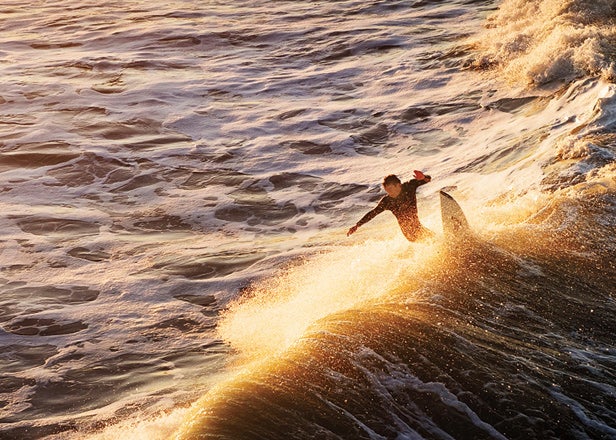
The “wilderness lodge” here has been elevated to a high art form, with a price to match, though the cost is often offset somewhat by the inclusion of meals. The offerings range from classic genteel oases to slick 21st-century adventure hubs, with square-jawed guides, 500-bottle wine lists, and heli-everything.
The North Island’s Huka Lodge is the archetype of the former category. What started out as a fishing camp in 1924 has become so discreetly luxurious, with its private suites on the Waikato River, 17 perfectly manicured acres, and alfresco five-course dinners, that Queen Elizabeth II and Barbra Streisand have been known to relax here (suites from $590 per person, including breakfast and dinner; ).
Across the North Island and at the opposite end of the taste spectrum is Ahu Ahu Beach Villas, on the Taranaki Peninsula. This is actually a cluster of rustic villas set right on a black-sand beach with a killer view of 8,261-foot Mount Taranaki and immediate access to the local caf├ę scene and exhilarating wilderness walks. A handful of New Zealand’s best surf breaks are within a 20-minute drive (villas from $160 per night; ).
On the South Island, the adrenaline-sport scene in Queenstown has spurred a proliferation of lodges. One of the most consistently recommended is Blanket Bay, on the shores of Lake Wakatipu, 45 minutes north of Queenstown. Fly-fish, flight-see over Fiordland National Park, and dine in the wine cave while drinking local varietals (doubles from $750; ).
Or go ape on the South Island’s Pacific coast in the Hapuku Lodge & Tree Houses. The one-bedroom retreats, 30 feet off the ground in a manuka grove, are quintessentially KiwiÔÇöchic, stark, and ecologically correctÔÇöand each features a wood-burning fireplace and a couples bath. The Tarzan & Jane Tree House Retreat includes a one-night stay, a bottle of champagne, dinner, and breakfast ($1,015 per couple; ).
Take a Hike
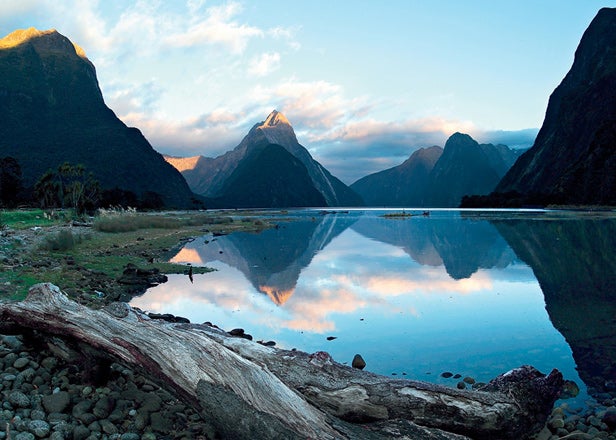
Tramping in New Zealand is like a national religion. The nine multi-day hut-to-hut Great Walks are exceptional and, thanks to Department of Conservation vigilance, often blissfully uncrowded. The Milford Track, a 33-mile route weaving through alpine terrain overlooking deep-walled fjords in the far south, gets the most buzzÔÇöand deserves it. The four-to-five-day trek starts with a boat journey across Milford Sound. Your first view: 5,551-foot Mitre Peak, jutting straight out of the water. The track climbs a 3,507-foot pass across ice fields, skirts 1,904-foot Sutherland Falls, and ends with another boat ride, across Lake Te Anau. You can reserve hut space, plus bus and boat tickets, for the November-to-April trekking season on the DOC Web site (roughly $340 for huts and transportation; ).
The 34-mile Abel Tasman Coast Track is tramping lite. It’s sunnier here on the north end of the South Island, the beech forests are interspersed with golden-sand beaches, the maximum elevation is less than 700 feet, and you’re more likely to find an impromptu campsite party with Danes and Germans than wilderness solitude. Beware: there are two low spots along the trekÔÇöOnetahuti and AwaroaÔÇöwhere high tides can cover the trail, so be sure to time it right. For your nights on the trail, choose from four huts ($27 per person) or 18 primitive campsites ($9 per person).
An alternate to the Great Walk circuit is Aspiring Guides’ () eight-day Gillespie Rabbit Pass Traverse, in Mount Aspiring National Park, about midway down the South Island. The longest guided trek in New Zealand, it cuts through everything from rainforests to hanging glaciers. Plus you can brag that you tagged the icy shoulder of Mount Awful (the treacherous summit is 7,201 feet). The guides double as camp cooks, and you stay in pre-pitched campsites and luxury mountain huts (from $1,830 per person).
Get Wet
New Zealand's Perth River
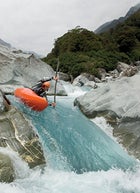 The Class V Perth River
The Class V Perth RiverNew Zealand has 9,400 miles of coastline plus hundreds of freshwater lakes and more than 125 whitewater rivers. Sailors blow around Auckland. Surfers kick back in funky Raglan. Whitewater paddlers gather on the South Island’s west coast, where milky Class V (and lesser) rivers rush to the Tasman Sea. Sea kayakers cruise all over. Which is to say, there are options.
An aggressive way to start: crewing a three-hour head-to-head sailing race on the retired 80-foot America’s Cup yacht NZL 41 in Auckland’s Waitemata Harbor ($150; ). For longer cruising adventures, the Bay of Islands, the archipelago off the northeast coast of the North Island, has summer temps in the high sixties and seventies, steady breezes, and some 150 islands with safe harbors. Great Escape Yacht Charters rents Davidson 20’s ($90 per day) or Noelex 25’s ($120 per day; ).
Surfing in New Zealand means packing a 5/3 wetsuit and, if you’re after serious swell, coming in the winter (April to June). Bring your shortboard and drop in on Raglan (on the west coast of the North Island), home to “the longest left in the world,” which is actually a series of three left-hand point breaks that jut from the foot of a dormant volcano. Crash at Solscape (close to hot spots Manu Bay and Ngarunui Beach), a beach house made completely from recycled timbers and native bricks (studios from $105; ).
Starting a rafting trip in a helicopter generally leads to good things. Hidden Valleys offers two-day trips on the Class V Perth and Class IIIÔÇôIV Whataroa rivers. You’ll fly to a gentle stretch of the snow-fed Perth, then drop steep gorges through temperate rainforest before flying to the put-in of the Whataroa, which offers Southern Alps views on the descent to the west coast ($670 per person; ).
Sea-kayaking Milford Sound is a classic Kiwi adventure, but nearby Doubtful Sound, in Fiordland National Park, is more than twice as long and much less visited, because getting there requires a 19-mile ferry ride across Lake Manapouri, followed by a 14-mile bus ride. ║┌┴¤│ď╣¤═° Kayak & Cruise leads day trips and overnight outings past 722-foot Helena Falls and Commander Peak, which stands almost 4,000 feet over the water (from $182; ).
Hook Up
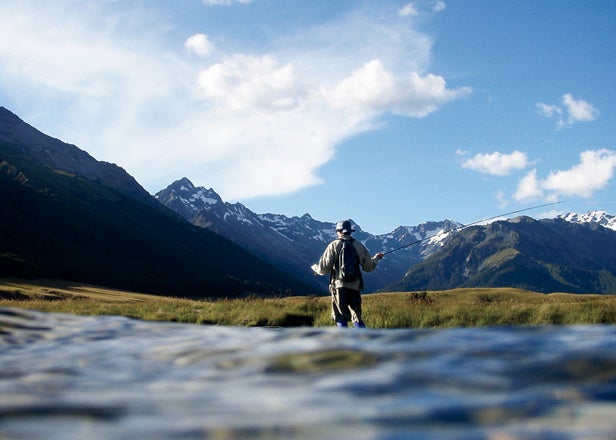
Fly-fishing here is serious sport. So much so that New Zealand has a nationwide ban on felt-soled boots, which spread microorganisms that can disrupt freshwater ecosystems. The quintessential Kiwi fishing experience is sight-casting dry flies in small, crystal-clear rivers for football-size brown trout. But it’s not easy: only a handful of New Zealand rivers have more than 1,000 fish per square mile (as compared with western U.S. rivers, with counts as high as 20,000). A guide is essential, and most of the best are based out of high-end lodges.
Mike McClelland, owner of the Best of New Zealand Fly Fishing (), can customize any trip. Among his favorite spots is the North Island’s Poronui lodge, a high-country estate surrounded by 25 miles of the choicest fishing in New Zealand. You can walk spring creeks, float wilderness rivers, or helicopter to remote streams (from $670 per person per night, including guides and meals; ).
Take a Spin
Queensland, New Zealand, mountain biking
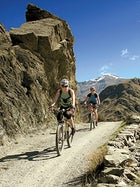 Queenstown
QueenstownMore than 350,000 tourists cycle in New Zealand every year. It’s no wonder: the country is safe, the scenery is stunning, and even the back roads are paved and well maintained. It’s also challenging: maritime winds blow year-round, and rain and traffic are common hazards. For the ideal combination of clear skies and empty roads, your odds are best in February.
Of all the great touring routes, the standout is the 550-mile South Island ride from Christchurch to Queenstown (plan for 12-plus days). Tip: when starting out, avoid busy Arthur’s Pass by pedaling farther north through Canterbury wine country to Lewis Pass. On the lush west coast along Highway 6, the formula is Tasman Sea views, natural wonders like Punakaiki’s pancake rocks (seaside rocks squashed flat), and quirky tourist attractions like Charleston’s famous glowworms (seriously, they glow). Camp in numerous Department of ConservationÔÇôdesignated sitesÔÇörocky beaches, leafy forestsÔÇöor stay in a cozy inn like Birds Ferry Lodge, near Charleston (two-night package with massage, $610 per couple; ). When the road turns inland, crank up 1,847-foot Haast Pass to Wanaka, then bomb down the zigzaggy Crown Range Road, the highest in New ZealandÔÇöwith views of the Remarkable Mountain Range and Lake WakatipuÔÇöall the way to Queenstown.
Two Christchurch-based outfitters to consider: NZ Bicycle Tours (), which can customize and guide you on any itinerary, and Natural High, which rents bikes one-way to Queenstown (sample prices: Specialized Sirrus, $30 per day or $300 up to for eight weeks; ).
Rope Up
Reminder: this is where Sir Edmund Hillary learned to climb. And he’s not the only one. New Zealand’s mountains make for ideal training peaks because they require skillÔÇöglacier travel, crevasse rescue, and weather predictionÔÇöbut no bottled oxygen. The South Island’s Mount Cook, at 12,316 feet, is the country’s tallest. But the best learning experiences for climbers with big ambitions are had on 9,951-foot Mount Aspiring, a highly technical peak in the Southern Alps with gorgeous views of the Tasman Sea. Aspiring Guides () offers a five-day (heli-assisted) trip or seven-day (walk-in, walk-out) climbs, with a guide-to-client ratio of 1:1. From $2,830 per person.
Get Amped
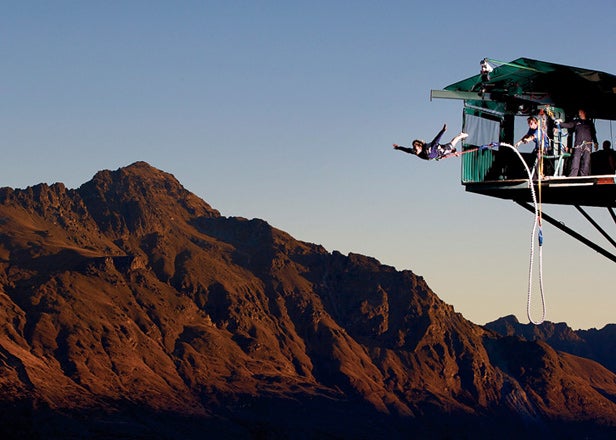
If an entire city could suffer from Peter Pan Syndrome, Queenstown might be the place. The “║┌┴¤│ď╣¤═° Capital of the World,” situated between Lake Wakatipu and the Remarkables, likely has the most thrill seekers per capita on the planet. AJ Hackett set up his first bungee jump here back in 1986. Today you can leap and boing-boing with his company at three Queenstown venues or pick from an ever-expanding list of outfits promising full-throttle fun rides: jet-boating through a river canyon, river surfing, canyon swinging (what it sounds like), canyoneering, or riding shotgun in a stunt plane (visit for most of these activities). Meanwhile, Queenstown has been Aspenized with a proliferation of world-class dining and five-star hotels. Why not mix and match? The Spire, a sleek ten-room downtown boutique hotel, offers a four-day Extreme Adrenalin Package that includes jet-boating, paragliding, bungee jumping, and a 15,000-foot skydive (doubles, $3,750; ).
Do It All
A number of veteran outfitters put together excellent taster’s-plate trips. Backroads’ eight-day North Island New Zealand Multisport (from $4,298 based on double occupancy; ) features cycling through the Hawke’s Bay wine country, hiking the Coromandel Peninsula, kayaking to a hot spring on Lake Rotoiti, and staying at Mangapapa Petit Hotel, a country estate surrounded by apple and peach orchards. Wilderness Travel’s 13-day South Island ║┌┴¤│ď╣¤═° ($5,195; ) includes hiking hot spots like Abel Tasman National Park, swimming with dusky dolphins on the Kaikoura Peninsula, touring Marlborough wine country, hiking the Fox Glacier, and taking an overnight cruise in Milford Sound.
For the eco-minded: Active New Zea┬şland’s brand-new Pounamu “Deep Green” road trip. The 13-day Christchurch-to-Queenstown route has clients riding a biodiesel bus, planting trees to offset their carbon footprint, eating and drinking 100 percent organic or locally sourced food and wine, and staying in lodges that have made sustainability their mission. Hit all the South Island highlights: hiking in Mount Aspiring National Park and along the Queen Charlotte, Abel Tasman, and Routeburn tracks; kayaking Marlborough Sound; biking in Wanaka; and swimming with dusky dolphins ($5,500; ).
The Best of the Rest
THE METRO KIWI
For all their adventure genes, Kiwis are very metropolitan. Auckland gets a lot of attention as the “City of Sails,” but Lonely Planet just ranked Wellington, the capital, number four in its 2011 list of the world’s best cities. Built on a hillside and overlooking a bay, this is the Kiwi answer to San Francisco: cool, close to nature, and compact. From a downtown bursting with caf├ęs and clubs, you can ride a bus 20 minutes to Makara Peak (), a 500-acre network of singletrack that overlooks the sailboats in the bay. The city of 410,000 is also packed with cultural creatives, like movie-industry icon Peter Jackson and outdoor-apparel entrepreneur Jeremy Moon, the founder of Icebreaker. The Ohtel, a new ten-room boutique inn, prides itself on its decadent bathrooms with oversize showers, two-person tubs, and views of the harbor (doubles from $175; ).
MAORI RISING
The indigenous Maori make up 15 percent of New Zealand’s population, but, like Native Americans in the U.S. and Aborigines in Australia, they have been marginalizedÔÇöso severely that by 1995 their language was facing extinction. Fortunately, the past 15 years have seen a renaissance, with the Maori population growing 28 percent and tourism dollars beginning to support an economy of local pride. The most inspiring success story is Kai┬şkoura, a village of 3,900 on the Pacific coast of the South Island. The Maori-owned Whale Watch offers a 95 percent chance of seeing a giant sperm whale and has become one of the hottest draws in the region (two-and-a-half-hour catamaran tour, $110; )
BUCK UP
The U.S. dollar doesn’t stretch as far as it used to here, but the exchange rate is still better than Canada’s or Australia’s (NZ$1.32 at press time). Three ways to get more for your money:
Airline Tickets: Round-trips to Auckland on most carriers cost around $1,000, but it can be cheaper to fly through Australia (as low as $800), thanks to 13 Aussie gateway cities. Consider doing a Down Under double.
Accommodations: Forget what you know about “hostels.” Kiwi hostels are clean, cut-rate hotels with TVs and bathrooms en suite (but bring a sleeping bag). At luxury hotels, try negotiating on the price: tourism numbers have plateaued since 2006.
Timing: Peak tourism season in New Zealand is generally late November to early March. But the weather can still be perfectly lovely in October and well into April, when deals are widely available.
Take Me Home
Seven years ago I became a New Zealand resident on a whim. Thank God.
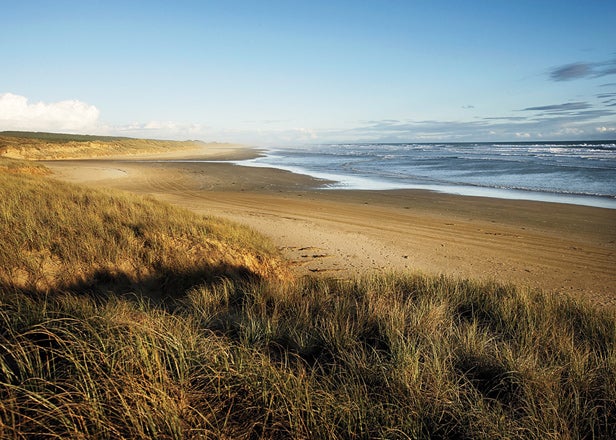
THERE’S NO ONE ON THIS BEACH, a wide crescent a half-mile long. Headlands at one end, sacred ground. Maori land. Exposed dark South Pacific rock, lush growth, tree ferns. I’ve seen the mist spill down over gaps in the ridge on early mornings, but it’s later now, and all is bright and clear and blue.
Taupo Bay, Northland. My wife, Nancy, is in the waves, twisting for tuatuas. Small clams. You go for them by wading into the sea and digging fast with your heel or toe. She’s laughing, going after a digger, doing the twist, and dips down with her hand just as a wave hits. She can see it coming, but she reaches down anyway, turns her face at the last moment, and I can see her smile. The wave passes over, white foam, and she holds up the white shell triumphantly.
What I’m seeing is a gift, my wife returned, the way I first saw her a dozen years ago, that same simple delight. And I remember now that this is why I love her, because she’s ready to be delighted by the world. And I know that this is why we’re planning our future here in the far north of New Zealand, because here we can remember who we are.
I’ve become too caught up in work and deadlines, and I’ve had to live in places where I didn’t want to live, in suburbias, suckling on pavement. I’ve felt locked up as tight as one of those clams, grown past the age of any sudden joy. But New Zealand always brings me back.
Partly it’s the land we bought seven years ago, 17 acres of grassy knolls and native totaras like perfect bushy Christmas trees along a hillside not far from Taupo Bay. We came here on a whim, but now I can’t imagine our lives elsewhere. I’ve thought of that land every day, longed for it, longed for the life we imagine, kept from it by work in the U.S.
But it’s more than that. New Zealand is the entire U.S. West Coast flipped into the Southern Hemisphere. When I hiked a ridge on the Kepler Track, in the extreme south, I saw the Alaska of my childhood, with snowy peaks, alpine lakes, exposed rock above dense forest. I was traveling light because of the great hut system, which provides a bunk and stove and water, and yet the entire time my wife was a small speck far ahead, because I just kept stopping and looking around.
On another trip, near Ninety Mile Beach, in the far north, we surfed giant white sand dunes with no other human present. There were cattails along the river, and then just a 20-foot wall of sand, with far larger dunes rising beyond. It was so unexpected, we laughed. “Our own Sahara,” Nancy said.
In Rotorua, we soaked in hot springs and hiked along bubbling mud and sulfur pits, a vacation on Mars. In Abel Tasman National Park, we paddled endless bays and coves with dolphins all around. And when we lived for a year on Waiheke Island, off Auckland, we sailed our small catamaran close along banded rock. I had one foot on the tiller, lying back on the trampoline, looking at the pohutukawa trees with their red blossoms, growing right from the cliff faces.
When I go to New Zealand, I feel the world has been remadeÔÇöor, more accurately, that I’ve found the original land from which others were formed. It’s a sense of peace that goes beyond the fact of no snakes and no poison oak. New Zealand is a place of very little population, of an earlier friendliness, where fences are only for sheep and cattle. The kids here walk around without shoes, even in the colder regions. Most families own their house, and despite the two-decade onslaught of tourists and expats like me, hardly anyone locks their door. When my wife cycled around the country for six months, she couldn’t take a rest break without every passing car stopping to see if she needed help.
The only fear we’ve felt was of Lappie the sheep. He’s a legend on Kahoe Farms, the hostel our friends run a few miles south of Whangaroa Bay. A wicked head butt to the knees and not afraid of people at all. Once, Lappie was brought to another farm to get a ewe pregnant, which he was happy to do, but unfortunately someone brought another male. Instant fight. They were separated, but in the night, Lappie broke through the fence and killed his rival. A few years ago, my wife and I were on a hike and Lappie was waiting for us on our return, right on the path. Like cowards, we crossed a stream to the other side and ran away. Since then, though, the Great Shepherd has come for Lappie, and we’ve been given his skull. It’s currently drying on our friend’s roof, and we plan to erect a shrine to him on our land.
There’s a nearly immutable law in the world that everything gets smaller as you step closer to it, but that law is suspended in New Zealand. When my wife and I first arrived, in 2003, we were already residents, our applications having been approved while we were still in the U.S. And we were a little anxious. We’d done some stupid and impulsive things before and paid a price. But when we stepped off the plane, the immigration agent said, “Welcome home.”



